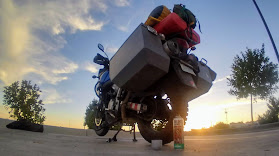 |
| Chain maintenance back in New Mexico. Yes, I've lubed the chain plenty of times since then, but this is the last photo I could find. |
After narrowly avoiding tipping my bike over onto Nick's due to the center stand sinking unevenly into the small patch of soft sand below the bike, I was able to find a scrap of wood to provide adequate support. And the the job started easily enough. The clutch slave cylinder and front sprocket housing came away with no issue, and the safety screw on the front sprocket came off without a hitch. But then: the massive, 32mm nut, itself. It does the lion's share of holding the front sprocket on. I knew that this was going to be an issue, as the manual prescribes more torque for this nut (83 ft-lb) than for anything else on the bike.
I wrapped a rag around a scrap of found rebar (don't need it scratching things up!) and stuck it through the rear wheel, effectively locking up the whole drive system. (At home, I usually use a 2x4 for this, which is adequately stout but unlikely to damage the wheel or swingarm.) But when I went to loosen the 32mm nut, I was putting so much pressure on the socket that I feared the ratchet might break. I needed another solution: both a stronger ratchet, as well as a method to apply greater torque.
After burning a bit of daylight cleaning out the clutch slave cylinder housing, I headed toward the centro on errands. First thing's first: we dropped Nick's bike off at the Yamaha dealer, who said that parts should be arriving that afternoon. By now, we know that was a big load of "nope". We checked on a laundry, but had no luck, so Nick headed back to the hotel while I turned toward the strip of little hardward stores (ferreterias) to see if I could find a 1/2”-drive ratchet.
When I had asked the Yamaha dealer where I might find a 1/2"-drive ratchet, I was referred to a large hardware store across town, requiring a cab ride. Before hailing a cab, though, I figured I would at least try a couple of the ferreterias in the market. Lo and behold, the first shop I stopped at had exactly what I was looking for. Problem 1: solved for a mere 26 soles (~$8 USD).
Now for more torque.
About a 2-foot scrap of metal pipe would be optimal to serve as a breaker bar by extending the handle of the ratchet. Interestingly, such a thing proved quite hard to come by. I stopped into several ferreterias, eventually locating a heavy-duty rebar stake with a loop in one end. The loop fit over the end of the new ratchet (more or less), so it would suffice if I couldn't find a pipe. I bought it for 8 soles (~$2.50 USD), but there were a few more ferreterias on the block, so I kept asking. After awhile, I’d stopped into a dozen or so shops, some of which had plastic pipe, but no metal pipe. They all tried to be helpful, but couldn't come up with anything that would do the trick. But the clerk in one of the shops had a look of recognition in his eye. He new what I was trying to do and disappeared into the back of the shop with my new ratchet for a few minutes. When he returned, I was delighted to see that he held a 2’ piece of 1.5” metal pipe. Perfect! At 20 soles (~$6 USD), it may not have been a bargain, but it was exactly what i was hoping to find.
 |
| All told, I spent 54 soles (~$16.50 USD) for a 1/2"-drive rather, a couple feet of 1.5" pipe, and a solid chunk of rebar. Just the tools for the job! |
How fortuitous that I had just purchased another, thicker hunk of rebar! I’d kept it even after I found the pipe, and now it was going to come in useful. With it in place replacing the found rebar, I put my weight behind the pipe-ratchet combo and, begrudgingly, the nut came loose.
From there, it was just a matter of order of operations: breaking the old chain, removing it, removing front and rear sprockets, installing the new sprockets, and installing the new chain.
By comparison, the old sprockets were clearly worn.
 |
| Old sprocket resting on the new sprocket. Notice the worn, pointy teeth on the old in comparison to the new. |
 |
| Another shot of the old and new sprockets for comparison. The new one is bigger because it has more teeth, which will provide more pep, though at slight expense to the fuel mileage. |
The Old
|
The New
|
|
|
And, a quick (very quick!) time lapse of the process:



















































